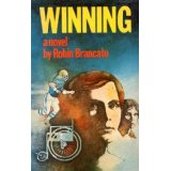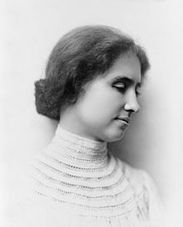 From time to time, I've thought to myself I'd like to find more sports-related books for my children. Today I opened a care package from my mother. Inside, were the usual niceties she likes to send: activity books for the kids, some little notepads and stickers, some coupons and...a book. The book was called Winning. A Novel by Robin Brancato. This book looked familiar to me. I thought, 'Oh, my parents must have found one of my old books up in the attic, and decided to include it in the care package.' Well, yes and no. It was one of my old books. Inside, was the elaborate scrawl that I used to sign my books with, along with the date I had acquired it. April 9, 1988. In the corner someone had penciled $3.00, so it was clearly bought second-hand from my local Wynnefield Library book sale (remember, the most beautiful library in the world). I don't know why I had picked it up as a teenager, actually, since I never really liked sports-themed books. As it turned out, though, Winning is the story of a young football player whose life is turned upside down by tragedy, so not a typical sports story at all. Although I only read this one once, it was an extremely compelling read. But when I left home to go to graduate school in 1993, I remember giving away a bunch of my old books to a local Goodwill, a few towns away from my parent's house in Philadelphia. Winning was one of those books. In the note I received today, my mother wrote: "We found this book in the Overbrook Train Station Book Swap." The Overbrook train station is just a few blocks from my parent's home in Philadelphia. So, almost exactly TWENTY YEARS LATER, the book returned to my parents, and they returned it to me. Where has the book been for twenty years? I'll never know. I do know I will save it for my children to read--I don't think they would have ever read this amazing story otherwise. But maybe this is just a reminder that sometimes when you throw a question to the universe, you never know how you'll be answered...and perhaps that's the fun of it. What do you think? Have you ever tossed a question to the universe and seen it answered in strange ways?
4 Comments
I posted this a few days ago, but I realized there's one more important thing to remember!!!  Tonight I am going to do something I haven't done since I was in grad school. I am going to get a pair of scissors and physically cut up the first two chapters of my current work-in-progress (WIP). Sure, I know about the cut-and-paste function in Word. Sure, I've heard of outlines. This extreme method of cutting probably seems crazy. But I have to say, it is easiest way I know to physically see all the redundancies, missing passages, dangling storylines, etc. that can really plague a manuscript. Plus, it's fun. And somewhat cathartic. Most importantly, it lets the WIP know who's boss. From experience, though, I've learned a few things... 1. Don't cut more than 20 pages at a time. More that then, then you'll just end up weeping in a corner, looking at the little scraps of paper all over the living room floor. Which leads me to point two. 2. Don't try this on your desk or at the kitchen table. You'll never have enough room to see all the scraps at once. You'll need an entire floor to work on. Which leads me to point three. 3. Choose a floor where the cat won't roll around. Nearly impossible in my house. But I have a solution to this problem. Lay out an empty box next to your scraps. Your cat will stay in the box. 4. Number as you go. Personally, I use elaborate coding schemes, numbering my paragraphs in the order they go. 1A, 1B, insert 2D here, put 1/2 of 17 here, and last half of 13 here. But sometimes I forget my ordering system. So, 4a. Don't forget your coding scheme. 5. Don't forget the tape!!! The best part of this process is taping together your newly structured WIP. You'll feel really invigorated and happy, I promise. But this brings me to point six. 6. Pour yourself a nice glass of wine. No, not to celebrate. That comes later. But rather to ease the inevitable shrieking and tearing of hair that will occur when you realize that you have to sit down at the computer and make all these tedious changes. 7. Promise yourself that next time, really, you will write in a more orderly way. If not, it's on to chapter 3 and step one above. But I'm curious! Has anyone else done this old school cutting and pasting? Do you find it works? Or am I raving bonking mad? ••••••••••••••••••••••••••••••••••••••••••••••••••••••••••••••••••••••••••••••••••••••••••••••••••• And now my addendum...
8. Don't double-side when you print! Like I did. Boo!!! Sort of defeats the whole purpose.  As I move along the path from "writer" to "author," I've become aware of something that's simultaneously wonderful and daunting: PEOPLE ARE READING MY BOOK. Of course, for the last sixteenth months or so people have been reading A Murder at Rosamund's Gate (due out April 23, 2013). My alpha reader. My beta readers. My agent. My editor, multiple times (thank you Kelley!). Copy editors. Proofreaders. Marketing people. Publicists. But now... Readers. Reviewers. People who've won advance copies in giveaways. People I don't know, and may never know. Many seem to have enjoyed my book, although a few--well--haven't. In my day job, I spend a lot of time helping faculty find something constructive even in the most negative student comments. And I think I can learn from my readers too. But because I can't--and probably shouldn't--address reviewers directly, I'd just like to take a moment to say thanks. Thanks to everyone who spent the time reading my book, and for writing a review. Even if my book wasn't for you, I appreciate you spending the time thinking about my book. And if my book was for you...well, the next Lucy Campion mystery will be out next year!  Mary Amelia Ingalls (1865-1928) Until yesterday, if you had asked me what I knew about scarlet fever, I would have been able to tell you two things: A lot of people seemed to have contracted it in the nineteenth century, and in severe cases, a person could die, or at least go blind. My evidence? Well, Laura Ingalls Wilder of "Little House" fame attributed her sister Mary's blindness to scarlet fever. I, for sure, took this diagnosis at face value. Why wouldn't I? However, as it turns out, Mary probably suffered from viral meningoencephalitis. In a recent Pediatrics article, Dr. Beth Tarini and some colleagues reported their reassessment of Mary's condition, having spent years pouring over Laura's letters and other documents which alluded to Mary's symptoms. Even though Mary had indeed contracted the disease as a child--in both the TV show and the book, we were infomed that "her eyes had been weakened as a child"--other symptoms were more telling. She went blind as a teenager, in 1879. Half her face had apparently been paralyzed, along with her eye muscles. Most telling of all, Laura later refers to Mary's "spinal sickness" in a letter to her daughter Rose. In 1881, Mary went to the Iowa Braille and Sight Saving School.  Helen Keller, 1880-1968 Interestingly, a thousand miles away in Alabama, Helen Keller--an infant-- had also just contracted a disease that caused her to lose her sight and vision. Like Mary Ingalls, her condition was also attributed to scarlet fever. Physicians now suspect, however, meningitis was the more likely culprit. Was the assumption of scarlet fever simply a misdiagnosis? In the case of Helen Keller, this is quite possible. In the case of Mary, no. Dr. Tarini's team concluded that the family was aware of Mary's true disease, but that Laura had deliberately obscured the nature of her sister's condition when she discussed it in her books. Why would Laura have changed her sister's disease? Dr. Tarini conjectured that scarlet fever, being a common malady, would have been more relatable to the author's audience. There's something to that hypothesis, for sure. However, at the end of the nineteenth century, there was a real stigma associated with "brain fever," a catch-all term for neural sicknesses like meningoecephaliti and meningitis). After all, this was the era of both the rise of psychology and neurology, and the accompanying classification of mental disorders and illnesses. So Laura's rewriting of her sister's history was likely because scarlet fever was more palatable, not just more relatable. Laura is certainly not the first person to hide her family's secrets, or to rewrite her narrative. The tragedy of her own husband--Almonzo--is another example of how she reconstructed her past. But perhaps that's the greatest feat of a storyteller. Telling the story we want to hear, not what really happened. In this case, however, Laura's retelling has probably caused generations of people to associate scarlet fever with blindness, which is certainly incorrect. Yet another reason to constantly question what we read; to question what we know to be true. But what do you think? |
Susanna CalkinsHistorian. Mystery writer. Researcher. Teacher. Occasional blogger. Categories
All
Archives
May 2023
|
 RSS Feed
RSS Feed